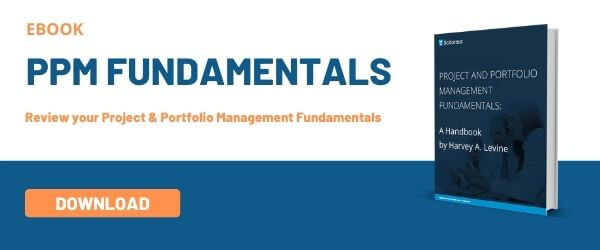- Home
- Blog Center
- 10 KPIs for Achieving Successful PPM Outcomes
10 KPIs for Achieving Successful PPM Outcomes
Return on Investment (ROI) is perhaps the most ubiquitous concept in today’s business. When it comes to achieving successful PPM outcomes, many senior managers, stockholders, or decision makers define project ROI as success and will base a variety of decisions upon expected or realized ROI.
Projects are investments too, and they are key contributors to the overall ROI of most organizations. Disappointing project ROI can result from execution and performance issues, as well as poor project selection. For this reason, project managers must understand how projects contribute to ROI, in order to choose the projects that will generate the highest return on investment. For each potential project, you need to consider whether the expected return warrants the investment, and how the opportunity ranks among all the considered projects within a projected portfolio.
Return on Investment is, simply, the product of output over input. Yet this straightforward mathematical formula has a number of shortcomings:
- It does not account for the time value of money or cash flow irregularities
- It is expressed as a percentage and not as a value
- And most of all, it typically fails to consider uncertainty, risk impact, qualitative factors, and strategic alignment
A number of other methods can help refine the evaluation of project contribution to business success, including more comprehensive financial metrics, other business indicators, and qualitative approaches to value appraisal.
Here is an overview of 10 key indicators that project management leaders can use for achieving successful PPM outcomes.

Financial KPIs for Achieving Successful PPM Outcomes
When talking about value appraisal, financial metrics first come to mind. Many variants of ROI calculations can help estimate the profitability of potential project investments from different perspectives.
1. Net Present Value
At the foundation of the concept of Net Present Value (NPV) is the understanding that time affects the value of cash flows. A cash flow occurring today has higher value than the same flow some months or years from now, because it can be invested and start earning returns without delay.
The NPV method calculates the current value of all cash inflows and outflows related to an investment over its life, using a given “discount rate” (usually the cost of capital, or the return that could be earned from alternative investments with similar risk levels). The higher the balance, the more attractive the investment opportunity. This simple tool lets you determine easily whether a candidate project would result in a net profit or loss over time.
2. Discounted Cash Flow
Also using the concept of the time value of money is the Discounted Cash Flow (DCF) analysis. A component of NPV calculation, the DCF method determines the present worth of the projected cash flows from a candidate project. But, unlike NPV, DCF doesn’t take into account the initial cash outlay, only the future flows. Accordingly, it can help inform how much you should invest today and how long it would take to get the desired payback.
3. Internal Rate of Return
Another NPV-related tool is the Internal Rate of Return (IRR), defined as the discount rate that sets the NPV of all future cash flows equal to zero using the same formula. The IRR defines the expected compound annual rate of return from an investment, making it a very useful instrument to compare different potential projects.
4. Payback Period
The Payback Period of an investment is the length of time needed to recover the funds expended, or to break even. You can calculate Payback Period by dividing the amount invested by the annual net cash inflow. A shorter Payback Period typically boosts the attractiveness of an investment.
5. Expected Commercial Value
The Expected Commercial Value (ECV) method is a construct used to assess and maximize the commercial value of a project portfolio. It takes the form of a staged decision tree with different project scenarios and outcomes, each being assigned a NPV and a probability. The Expected Commercial Value itself is the product of all NPVs and odds across scenarios. A risk-adjusted NPV taking into account the probability of commercial and technical success, ECV is ideal to evaluate innovation projects and decide between projects in uncertain contexts.
6. Weighted Average Cost of Capital
The Weighted Average Cost of Capital (WACC) is the average rate of return that an organization should compensate its various providers of capital – whether equity holders or lenders, with each category being proportionately weighted. In other words, your organization’s WACC sets the minimum return that your projects should yield in order to retain investors – your minimum viable return. A higher WACC tends to put investment activity under strain.
7. Accounting Rate of Return
The Accounting Rate of Return (ARR) is a ratio reflecting the expected return from a project over its lifetime. Find it by dividing the average annual net profit by the initial outlay. ARR factors in asset depreciation – an accounting convention spreading out the cost of a fixed asset over its useful life – but it fails to consider the time value of money or long-term risk.
Business KPIs for Achieving Successful PPM Outcomes
Although financial data and metrics are at the core of value appraisal, they do not provide a complete measure of the potential benefits of a project. As they focus on a set of standard inputs, they leave out other factors that may have a significant impact on the overall return from your project – such as qualitative KPIs, which typically perform better when trying to assess risks and opportunities. For example, a project with lower IRR can still be worth your while provided it effectively positions your organization for the future. They may be harder to measure, but hard and soft business KPIs are crucial to evaluating the benefits and value of projects.
8. Cost Impact metrics
An organization’s cost structure and levels are key determinants of its long-term viability and ability to compete. When evaluating prospective projects, be mindful of the consequences they may have for your costs – through positive or negative effects on resource consumption, asset management, procurement and supply chain, employee turnover, etc. The impact can be direct (for example, an initiative that involves outsourcing services or facilities will most likely reduce operating costs), or indirect (let’s consider a marketing project to revamp product look and feel, resulting in the development of less resource-intensive packaging). So you should try to embrace all the possible implications of the projects you are considering, always heeding the related risks and balancing threats and opportunities.
9. Efficiency & Productivity metrics
A project may lead to increased team or organizational performance through technical improvements, or may translate into improved team engagement, enhanced collaboration, streamlined processes, reduced project lifecycle, or other metrics with impacts on business productivity and resource efficiency. Conversely, direct or indirect project consequences may burden operations. Cast a wide net when analyzing a project, trying to identify any foreseeable effect on resource and asset productivity. Running simulations can help you measure the potential impact more accurately.
10. Market position metrics
A frequent aim of project activity is consolidating the organization’s market footing – especially for product-centric businesses, but not only. Projects are the ideal vehicle for improving market competitiveness: adding new delivery channels, developing new lines of products, conducting new advertising programs… They can help your organization bring new products or services to market faster, deliver timely innovations to meet new consumer expectations and market trends, or seize windows of opportunity. When considering candidate projects, try and measure potential project impact on market shares, sales growth, leads, cost of customer acquisition, but also qualitative, soft metrics such as brand image or customer experience.
Achieving Successful PPM Outcomes Beyond KPIs
We have considered numerous variations on ROI equations and various metrics to determine if projects are achieving successful PPM outcomes. While it is a good idea to mix and match to examine a project from different angles, it is important to follow a consistent approach in order to be able to track and compare projects.
Most importantly, always consider the measurements and assessments against the backdrop of strategic goals. Your organization’s strategies should be the main drivers for project selection and ranking criteria. Whatever KPIs you choose to use, they should ultimately contribute towards answering the key questions: “How does this project support the firm’s strategies?” or “Which strategic initiatives are supported?” Risk is another factor that should always be considered in ROI-type calculations. Although it is often overlooked, project risk is a key ingredient in accurate, realistic value appraisal.
Finally, on a more practical note, the success of your effort to assess project return hinges upon your ability to collect and maintain relevant data and to leverage powerful data analytics, with the capability to compute possible outcomes and to simulate scenarios. The best way to attain this kind of superior data intelligence is using a robust, value-oriented project portfolio management platform.








Camélia Docquin
Camélia is Sciforma’s Global Marketing Director and enjoys learning different perspectives of the current business environment and project management challenges that enterprises and individuals face daily. Main interests include : innovation, digital transformation, and strategy execution.